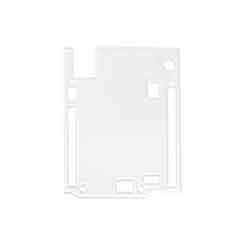- sales/support
Google Chat: zj734465502@gmail.com
- sales
+86-0755-88291180
- sales01
sales@spotpear.com
- sales02
dragon_manager@163.com
- support
tech-support@spotpear.com
- CEO-Complaints
zhoujie@spotpear.com
- sales/support
WhatsApp:13246739196
- HOME
- >
- ARTICLES
- >
- For Arduino
- >
- Mother Board
Arduino DUE pin introduction
Arduino Due pins
The Arduino Due is based on a 32-bit ARM core. This is the first Arduino board developed based on an ARM microcontroller. It has two ports called native USB port and programming port.
The bow|foot arrangement for the Arduino Due is as follows:

Detailed:
Receive and Send
Lighting of the TX and RX LEDs indicates successful data flow. power pin
Power pins include GND (ground), 5V, 3V3, Vin and IOREF pins.
GND :These are the ground pins which are used to ground our circuit.
5V : 5V3 pin is used as 5V output regulated voltage. The 5V power supply for the Arduino Due board is the USB connector, DC power jack and Vin. The board can be powered from any of the above-mentioned sources.
3V3 : The 3V3 pin is used as a 3.3V output regulated voltage. It can provide power for SAM3X microcontroller.
Vin :Defined as the input voltage, which is applied to the Arduino board when it uses an external power supply.
IOREF :Represents the input and output voltage reference. It allows the shield to check the board's operating voltage (3.3V or 5V). The shield is connected to the Arduino board.
The microcontroller works with the reference voltage provided by IOREF.
Analog pin
Pins numbered Ao, A1, A2, A3, A4, A5, A6, A7 , A8, A9 , A10 and A11 are analog pins. The analog bow | foot function is to read the analog sensor used in the connection. It can also be used as a GPIO (general purpose input
Digital pin
There are 54 digital input/output pins. The value of the digital pin|pin is HIGH or LOW. The pins marked from 0 to 53 are the number bow|pins.
SPI communication
SPI stands for Serial Peripheral Interface and it is considered as a serial communication system. It uses conductors for data reception, data transmission, synchronization and device selection (for communication).
It can communicate quickly over short distances. It is also used to communicate between two microcontrollers.
I2C communication
I2C (Inter-Integrated Circuit) is a serial communication protocol that uses SCL (Serial Clock) and SDA (Serial Data) to receive and send data between two devices.
ADC voltage
ADC (Analog to Digital Converter) is used to map voltage values to integer values. Voltages from 0 to 5 are mapped to integers from 0 to 1023. The ADC in the Arduino Due is a 10-bit 6-channel converter.
Delete button
The "Erase" button on the board allows to erase the SAM3X's flash memory. To erase we need to power up the board and hold down the "Erase" button for a few seconds.
It will delete or erase the current sketch loaded in the MCU.
Reset button.
Used to add a "reset" button to a connection. To reset the microcontroller we need to hold down the reset button.
Usb port
It allows the development board to be connected to the computer. This is essential for programming the Arduino Due.
We usually plug the USB cable into the programming port to load the sketch onto the board.
Programming USB port
The programming port is connected to a high-performance 8-bit microcontroller (ATMEL 16U2), which also acts as a USB-to-serial converter.
Local USB port
The native port is directly connected to the SAM3X MCU. It uses the serial USB object to support CDC communication device class) serial communication.
Power jack
The adapter can be plugged into the power jack to connect it to the Arduino Due board.
32-bit ARM controller
The use of a 32-bit ARM controller makes the board useful for large-scale projects. An AC to DC adapter is mounted on it, which acts as the power supply for the board. It's only consistent with shields that operate at 3.3V. It is based on Atmel
SAM3X8E ARM Cortex-M3 CPU.
PWM output
PWM (Pulse Width Modulation) pin is used to convert digital signal to analog signal. The pins labeled 2 to 1 3 can be used as PWM output pins.
Serial communication
Serial ports are also known as UART ports. It communicates with the computer using a USB port. It is also used to communicate on the transmit LEDs called TX and RX.




